
Maribor is the second-largest city in Slovenia and the largest city of the traditional region of Lower Styria. It is also the seat of the Urban Municipality of Maribor, the seat of the Drava statistical region and the Eastern Slovenia region. Maribor is also the economic, administrative, educational, and cultural centre of eastern Slovenia.
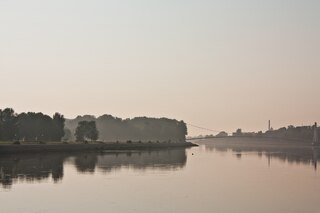
The Drava or Drave, historically known as the Dravis or Dravus, is a river in southern Central Europe. With a length of 710km, or 724km, if the length of its Sextner Bach source is added, it is the fifth or sixth longest tributary of the Danube, after the Tisza, Sava, Prut, Mureș and likely Siret. The Drava drains an area of about 40,154 square kilometers. Its mean annual discharge is seasonally 500m³/s to 670m³/s. Its source is near the market town of Innichen, in the Puster Valley of South Tyrol, Italy. The river flows eastwards through East Tyrol and Carinthia in Austria into the Styria region of Slovenia. It then turns southeast, passing through northern Croatia and, after merging with its main tributary the Mur, forms most of the border between Croatia and Hungary, before it joins the Danube near Osijek, in Croatia.
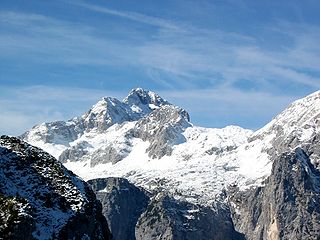
Slovenia offers tourists a wide variety of landscapes: Alpine in the northwest, Mediterranean in the southwest, Pannonian in the northeast, and Dinaric in the southeast. They roughly correspond to the traditional regions of Slovenia, based on the former four Habsburg crown lands. Each offers its own natural, geographic, architectural, and cultural features. Slovenia has mountains, meadows, lakes, caves, and the sea, making it an attractive destination in Europe.

Dravograd is a small town in northern Slovenia, close to the border with Austria. It is the seat of the Municipality of Dravograd. It lies on the Drava River at the confluence with the Meža and the Mislinja. It is part of the traditional Slovenian provinces of Carinthia and the larger Carinthia Statistical Region.

Ptuj is a town in northeastern Slovenia that is the seat of the Municipality of Ptuj. Ptuj, the oldest recorded city in Slovenia, has been inhabited since the late Stone Age and developed from a Roman military fort. Ptuj was located at a strategically important crossing of the Drava River, along a prehistoric trade route between the Baltic Sea and the Adriatic. The area is part of the traditional region of Styria and was part of the Austria-Hungarian Empire. In the early 20th century the majority of the residents spoke German, but today the population is largely Slovene.

Styria, also known as Slovenian Styria or Lower Styria to differentiate it from Austrian Styria, is a traditional region in northeastern Slovenia, comprising the southern third of the former Duchy of Styria. The population of Styria in its historical boundaries amounts to around 705,000 inhabitants, or 34.5% of the population of Slovenia. The largest city is Maribor.
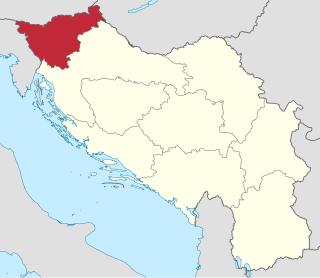
The Drava Banovina or Drava Banate, was a province (banovina) of the Kingdom of Yugoslavia between 1929 and 1941. This province consisted of most of present-day Slovenia and was named for the Drava River. The capital city of the Drava Banovina was Ljubljana.

Ljubljana Castle is a castle complex standing on Castle Hill above downtown Ljubljana, the capital of Slovenia. It is a key landmark of the town. Originally a medieval fortress, it was probably constructed in the 11th century and rebuilt in the 12th century. It acquired its present outline with an almost complete overhaul in the 15th century, whereas the majority of the buildings date to the 16th and 17th centuries. Initially a defense structure and since the first half of the 14th century the seat of the lords of Carniola, it was since the early 19th century used for various other purposes and today is used as a major cultural venue.

Brežice Castle is a 16th-century castle in the town of Brežice, in southeastern Slovenia, at the street address Cesta prvih borcev 1.

Slovenia has more than 28,000 wineries making between 80 and 90 million litres annually from the country's 22,300 ha of vineyards. About 75% of the country's production is white wine. Almost all of the wine is consumed domestically with only 6.1 million L a year being exported—mostly to the United States, Bosnia and Herzegovina, Croatia, and lately the Czech Republic. Most of the country's wine production falls under the classification of premium (vrhunsko) wine with less than 30% classified as basic table wine (namizno vino). Slovenia has three principal wine regions: the Drava Wine-Growing Region, the Lower Sava Wine-Growing Region, and the Littoral Wine-Growing Region.
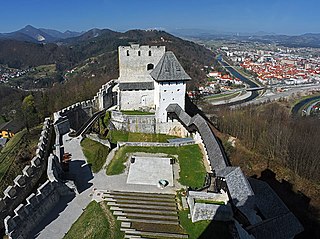
Celje Castle, also known as Celje Upper Castle or Old Castle, is a castle ruin in Celje, Slovenia, formerly the seat of the Counts of Celje. It stands on three hills to the southeast of Celje, where the river Savinja meanders into the Laško valley. Today, the castle is in the process of being restored. It was once the largest fortification on Slovenian territory.
Gravisi–Buttorai Mansion is a mansion in Koper, a port town in southwestern Slovenia. It is a protected monument of local significance. The mansion is situated at Shoemaker's Street in the old town center. It was the seat of a branch of the Gravisi family, whose senior line had the title of Marquis of Pietrapelosa, first granted to Nicolò Gravisi in 1440.
The Studenci District is a city district of the City Municipality of Maribor in northeastern Slovenia. Notable landmarks include the Carinthian Bridge, which crosses the Drava River.
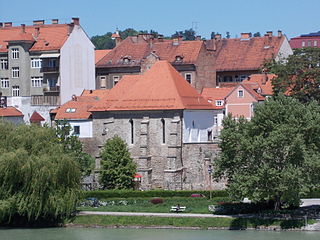
Maribor Synagogue is a former Orthodox Jewish congregation and synagogue, located in what was the center of the medieval Maribor ghetto Židovska ulica, in the city of Maribor, Slovenia. The former congregation was established in the 14th cnetury and worshiped in the Ashkenazi rite.
Plečnik Parliament is the colloquial name of two designs for a building intended to house the legislature of the People's Republic of Slovenia within the second Yugoslavia. Formally known as the Slovene Acropolis and the Cathedral of Freedom, the two designs were proposed in 1947 by Slovenia's most eminent architect, Jože Plečnik, but were rejected in favour of a more conventional design.

Haloze is a geographical sub-region of Slovenia. It is in the northeast of the country, in the Styria region.

The Judgement Tower is a fortified medieval tower in the city of Maribor, Slovenia. An original tower built on the site in the early 14th century secured the southwestern corner of the city walls. It was completely rebuilt in 1540, with the addition of a conical roof which burned down in the 17th century.

Holy Trinity Church is a historical building in Hrastovlje, a village in southwestern Slovenia. There are two hypotheses about its origin. According to the first, it is a Romanesque church from the 12th century. According to the second, it is an example of the Istrian variant of Early Venetian Renaissance architecture from the 15th century.

Metlika Castle is a 15th-century castle located above the old part of the town of Metlika in southeastern Slovenia, very near the Croatian border.

Castra ad Fluvium Frigidum, also simply Castra, referred to as mutatio Castra in Itinerarium Burdigalense, was a Late-Roman fortress (castrum) which constituted the centre of Claustra Alpium Iuliarum, an Ancient Roman defensive system of walls and towers stretching from the Gail Valley to the Učka mountain range. On its grounds, the Late Medieval market settlement of Ajdovščina developed.




















